Small-Scale Anaerobic Digestion for the Family Farm
 Team Members: Matt Pirog (BSEN, Lincoln, NE), Skylar Falter (BSEN, Lincoln, NE), Isaiah Krutak (BSEN, Lincoln, NE), Linkai Mei (BSEN, Hangzhou, China)
Team Members: Matt Pirog (BSEN, Lincoln, NE), Skylar Falter (BSEN, Lincoln, NE), Isaiah Krutak (BSEN, Lincoln, NE), Linkai Mei (BSEN, Hangzhou, China)
Faculty Consultant:Dr. Minarick
YearSpring 2015
We designed an anaerobic digester for managing the bedding and manure resources at a small-scale family farm in a manner that reduces labor, generates energy and provides a nutrient by-product for field application.TOP
ConAgra Cookie Topper
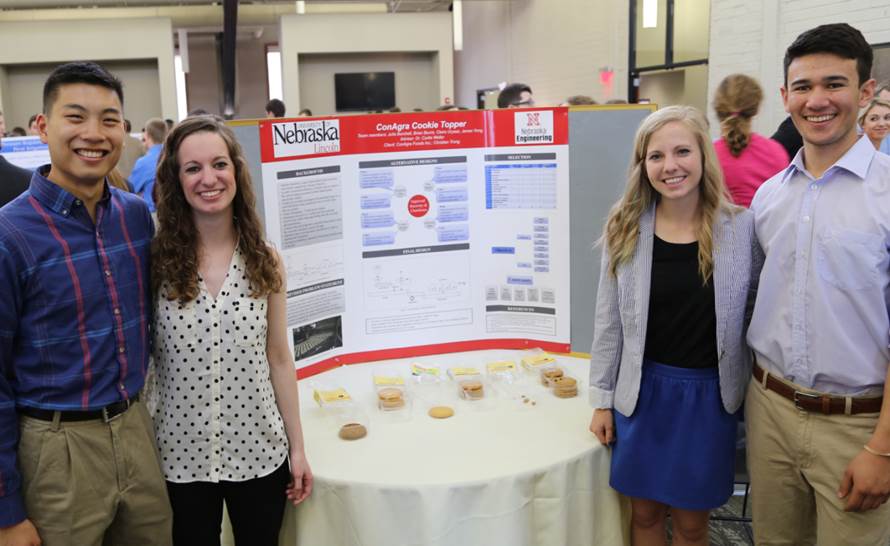 Team Members: James Yong (BSEN, Omaha, NE), Claire Uryasz (BSEN, Kansas City, MO), Julia Burchell (BSEN, Kearney, NE), Brian Burris (BSEN, Lincoln, NE)
Team Members: James Yong (BSEN, Omaha, NE), Claire Uryasz (BSEN, Kansas City, MO), Julia Burchell (BSEN, Kearney, NE), Brian Burris (BSEN, Lincoln, NE)
Faculty Consultant:Dr. Curtis Weller
Client:ConAgra
YearSpring 2015
The team has designed a mechanism that will more efficiently top cookies with granulated sugar in an assembly line. The design will minimize the loss of sugar that is not deposited on the cookie, thus decreasing the amount of sugar lost onto the belt. This increase in topping efficiency will lead to a more efficient process overall as ConAgra team members won’t be required to clean caramelized sugar from the conveyor belt as frequently.TOP
ConAgra Food Temperature
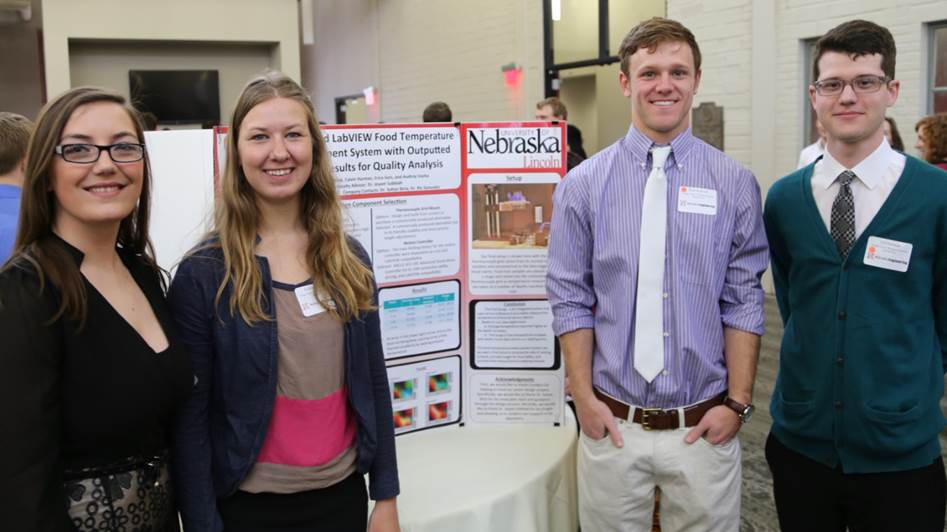 Team Members: Erica Geis (BSEN, Lincoln, NE), Audrey Vacha (BSEN, Omaha, NE), Matt Hedrick (BSEN, Granger, IA), Cal Harman (BSEN, Blair, NE),
Team Members: Erica Geis (BSEN, Lincoln, NE), Audrey Vacha (BSEN, Omaha, NE), Matt Hedrick (BSEN, Granger, IA), Cal Harman (BSEN, Blair, NE),
Faculty Consultant:-
Client:ConAgra
YearSpring 2015
The goal of this project is to design a system that records and graphs the temperature of foods at different depths. TOP
ConAgra Lofthouse Sugar Cookie Shelf Life Extension
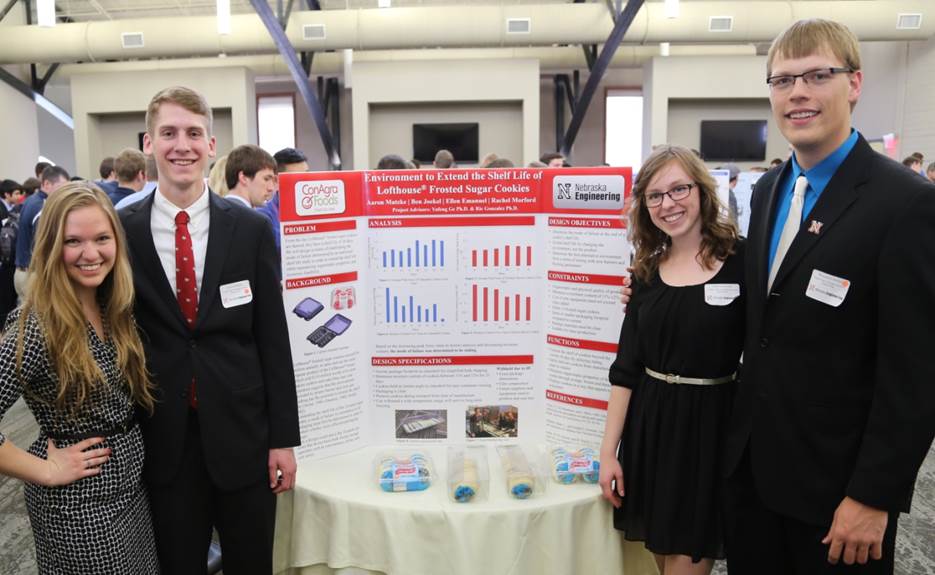 Team Members:Rachel Morford (BSEN, Dakota Dunes, SD), Aaron Matzke (BSEN, Lincoln, NE), Ellen Emanuel (BSEN, Gretna, NE), Benjamin Joekel (BSEN, Omaha, NE)
Team Members:Rachel Morford (BSEN, Dakota Dunes, SD), Aaron Matzke (BSEN, Lincoln, NE), Ellen Emanuel (BSEN, Gretna, NE), Benjamin Joekel (BSEN, Omaha, NE)
Faculty Consultant:Dr. Yufeng Ge
Client:ConAgra
YearSpring 2015
Currently, Lofthouse cookies are packaged in plastic clamshell containers and stored frozen until they are placed on a store shelf. From the day they are thawed on the shelf, they have a shelf life of 28 days. Extending the shelf life would broaden the consumer market for the cookies. Specifically, better packaging would allow them to be sold in stores that do not have sufficient freezer space to maintain the freshness of the current product. After collecting empirical data to determine the shelf-life mode of failure, we will recommend a new packaging design against the mode of failure in order to extend the shelf life of the cookies while maintaining their organoleptic properties and economic feasibility.TOP
Palm Fruit
 Team Members: Bonnie Cobb (BSEN, Omaha, NE), Lindsey Trejo (BSEN, Lincoln, NE), Camren LeFlore (BSEN, Omaha, NE), Andrew Taylor (BSEN, Brandon, SD), Ryan Burnett (BSEN, Lincoln, NE)
Team Members: Bonnie Cobb (BSEN, Omaha, NE), Lindsey Trejo (BSEN, Lincoln, NE), Camren LeFlore (BSEN, Omaha, NE), Andrew Taylor (BSEN, Brandon, SD), Ryan Burnett (BSEN, Lincoln, NE)
Faculty Consultant:Dr. Curt Weller
Client:-
YearSpring 2014
Identify and analyze three different equipment level alternatives, for processing of Awarra palm fruits in Suriname into an unrefined and oil based pulp extract, that range in size, scale, and cost for use by a single family to medium sized business. TOP
Automated Weight Filling Mechanism
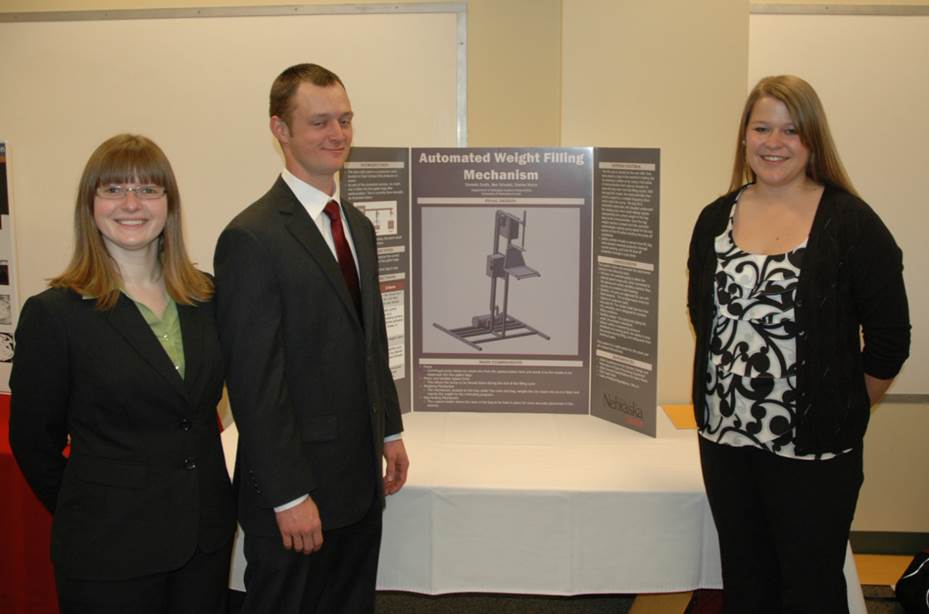 Team Members: Dianne Norris (BSEN, Ceresco, NE), Danielle Smith (BSEN, Gering, NE), Ben Schudel (AGEN, North Loop, NE)
Team Members: Dianne Norris (BSEN, Ceresco, NE), Danielle Smith (BSEN, Gering, NE), Ben Schudel (AGEN, North Loop, NE)
Faculty Consultant:Dr. David Jones
Client:Steven Weier, Pilot Plant Manager, UNL
YearSpring 2012
A conceptual design was developed for the dairy pilot plant on East Campus. Currently, ice cream mixes are manually filled into polystyrene bags for ease of storage and preservation. The new system automatically dispenses product into each bog using load cells to monitor the fill weight and various valves to control product flow. The system is controlled by an executable LabVIEW program and is expected to increase productivity and efficiency of the pilot plant by reducing operator fatigue.TOP
Automated Dilution System
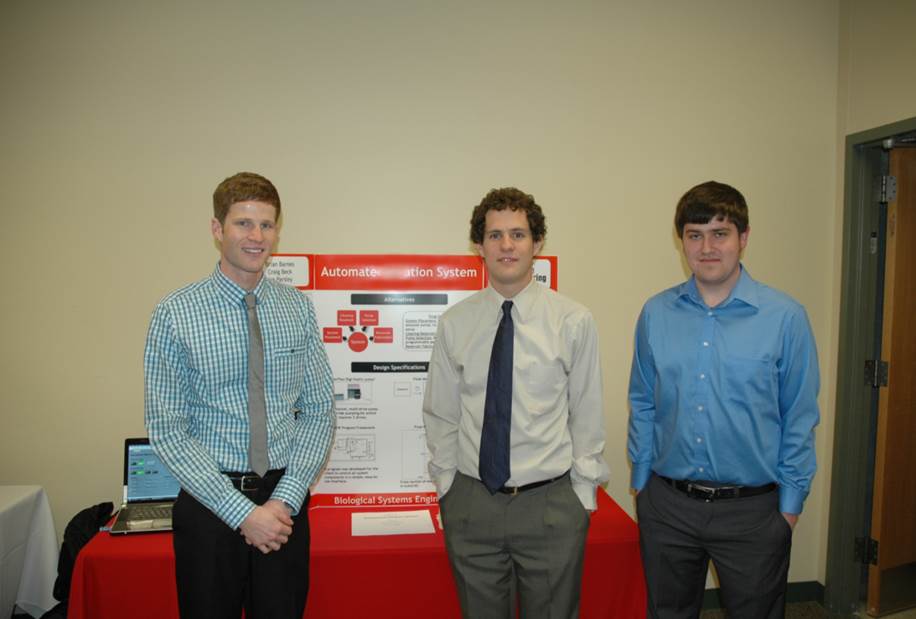 Team Members: Craig Beck (BSEN, Roca, NE), Brian Barnes (BSEN, Lincoln, NE), Ian Parsley (BSEN, Scottsbluff, NE)
Team Members: Craig Beck (BSEN, Roca, NE), Brian Barnes (BSEN, Lincoln, NE), Ian Parsley (BSEN, Scottsbluff, NE)
Faculty Consultant:Dr. Deepak Keshwani
Client:Chao “Michael” Tai, UNL
YearSpring 2013
The laboratory of Dr. Keshwani currently has a fed-batch bioreactor and analysis system for reading concentrations of sugars produced. The analyzer has a fixed range of analysis and the bioreactor is expected to produce concentrations that will exceed the analyzer’s effective range. Our team was to develop an automated dilution system that takes the samples from the bioreactor, dilutes them into the effective analysis range for the analyzer, and then get the diluted sample back to the analyzer.TOP
Foam Elimination System
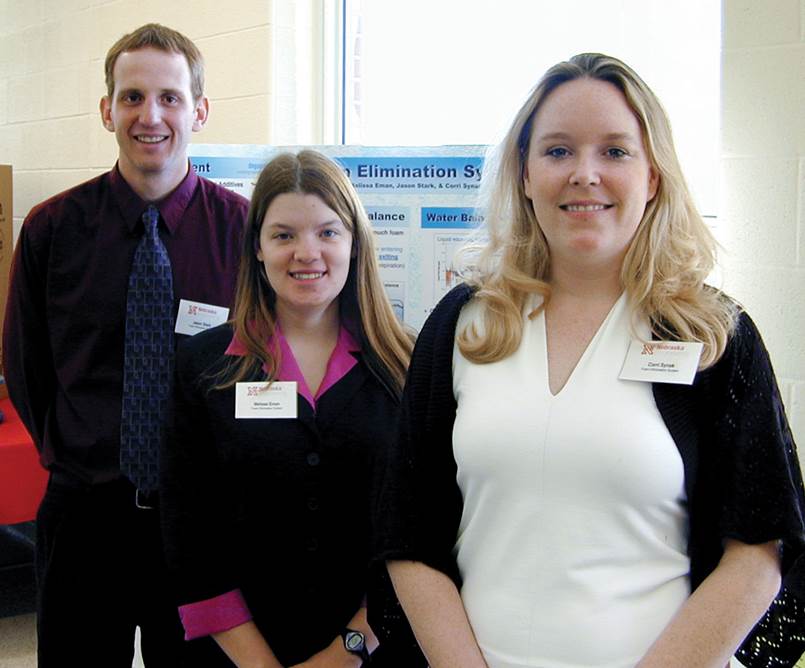 Team Members: Jason Stark (AGEN, Plainview, NE), Melissa Eman (BSEN, Peoria, IL), Corri Synak (BSEN, Lincoln, NE)
Team Members: Jason Stark (AGEN, Plainview, NE), Melissa Eman (BSEN, Peoria, IL), Corri Synak (BSEN, Lincoln, NE)
Faculty Consultant:Dr. Curt Weller
Client:Degussa Corporation, Cory Sander and James Thompson
YearSpring 2006
Fermentation processes naturally produce foam due to protein production and sparging air. The foam contains microorganisms used in the bioreactor. In extreme cases the foam production exceeds levels that are able to be controlled, and the foam becomes entrained in the exhaust air and leaves the plant. The issue that arises is how to control the foam when antifoam application is not sufficient. A water mass balance for both ideal and non-ideal operating situations was completed to determine the amount of water (foam) that was leaving the fermentation vessels during a given batch. It was determined that, under current operating conditions, existing control equipment was not sufficient to remove the foam from the existing air stream.TOP
Improving the Efficacy of Water use at Pfizer
 Team Members: Jennifer Muller (BSEN, Iola, KS), Hajira Ahmad (BSEN, South Sioux City, NE), Katrina Christiansen (BSEN, Pender, NE)
Team Members: Jennifer Muller (BSEN, Iola, KS), Hajira Ahmad (BSEN, South Sioux City, NE), Katrina Christiansen (BSEN, Pender, NE)
Faculty Consultant:Dr. Curt Weller
Client:Dave Koncak, Pfizer Inc., Lincoln, NE
YearSpring 2005
Water use at the Pfizer plant in Lincoln is a critical operational consideration. The objective of this project was to document and improve the efficacy of water use within plant focus areas that consume large amounts of water. The approach to this project involved collecting water use data, developing a schematic of water usage, examining alternatives concerning reusing, re-directing, and reducing water use, and retrofitting existing equipment.TOP
Improvement of Meat Skewering Machine
 Team Members: Nick Jarecke, AGEN, (Schnecksville, PA), Matt Foral, BSEN, (Blair, NE), Philip Christenson, AGEN, Aurora, NE)
Team Members: Nick Jarecke, AGEN, (Schnecksville, PA), Matt Foral, BSEN, (Blair, NE), Philip Christenson, AGEN, Aurora, NE)
Faculty Consultant:Dr. Curt Weller
Client:Steve Carstensen of Meyer Foods Inc. Lincoln, NE
YearSpring 2004
The team studied and offered solutions to Meyer Foods to improve certain problems in the company’s meat skewering machines. The team identified the problems and arrived at a design solution addressing breakdowns due to misalignment, jams in the hopper, and interface and sealing issues in the control box.TOP